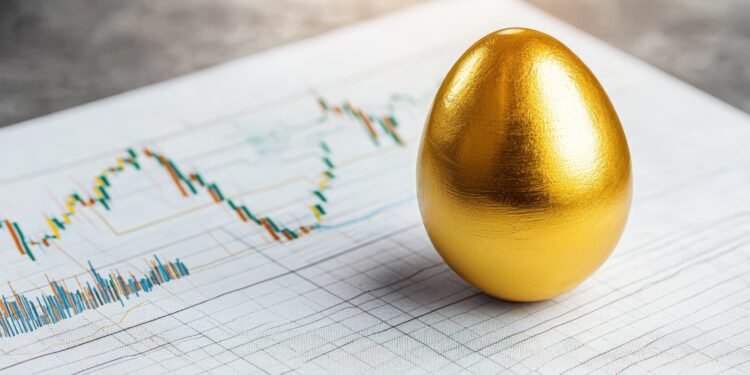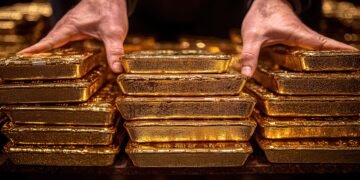In a significant market development, gold prices surged to unprecedented heights on Thursday as investors flocked to safe-haven assets following President Trump’s announcement of new automotive tariffs. This move underscores growing concerns about escalating global trade tensions and their potential impact on the world economy.
New Tariffs Trigger Gold Rally
By 11:30 a.m. ET on Thursday, spot gold had climbed 1.2% to reach $3,055.87 per ounce, after briefly touching a record peak of $3,059.48 earlier in the session. U.S. gold futures demonstrated even stronger performance, rising 1.5% to $3,068.80 per ounce and likewise setting a new all-time high.
Market strategists attribute this dramatic price movement primarily to heightened economic uncertainty. “Looks like we’re going to see (gold futures hit) $3,100 here shortly, and the main catalyst is safe-haven buying,” explained Bob Haberkorn, senior market strategist at RJO Futures. Haberkorn directly connected this trend to market uncertainty stemming from Trump’s latest tariff proposals.
The announcement from the White House detailed a substantial 25% tariff on imported vehicles. According to the plan, these tariffs will take effect immediately after Trump announces reciprocal tariffs targeted at countries he identifies as contributors to the U.S. trade deficit.
The international response has been swift and forceful. Multiple governments, including those in Ottawa and Paris, have already threatened retaliatory measures in response to these proposed tariffs. This escalating tension sent ripples through global financial markets, with stock indices declining and shares in major automobile manufacturers experiencing significant drops.
Monetary Policy Context
The gold rally is unfolding against a backdrop of evolving monetary policy. Just last week, the Federal Reserve decided to maintain its benchmark interest rate, while simultaneously signaling the possibility of rate cuts later this year. This policy stance has created additional support for gold prices, which historically perform well in low interest rate environments.
Market participants are now closely watching the upcoming U.S. Personal Consumption Expenditures (PCE) data, scheduled for release on Friday. This inflation indicator could provide crucial insights into the Federal Reserve’s future rate decisions.
Haberkorn highlighted the potential impact of this data release, noting, “If (the PCE data) comes out better-than-expected, it might signal more upside for gold… because the Fed would be in a better position to start cutting rates.” Lower interest rates tend to boost non-yielding assets like gold by reducing the opportunity cost of holding them instead of interest-bearing securities.
Goldman Sachs Raises Price Forecast
In a timely development coinciding with gold’s record-breaking performance, Goldman Sachs analysts have significantly increased their price forecast for the precious metal. The investment bank now projects gold will reach $3,300 per ounce by the end of 2025, marking their second upward revision this year.
In late February, Goldman had already adjusted their year-end target from $2,890 to $3,100 per ounce. This latest increase reflects growing confidence in gold’s bullish outlook among institutional analysts.
Lina Thomas and Daan Struyven, the Goldman analysts behind the revised forecast, pointed to unprecedented central bank purchasing as a key driver. Central banks globally have acquired over 1,000 tonnes of gold annually for three consecutive years and appear poised to maintain this pace throughout 2025.
“Central banks — particularly in emerging markets — have increased gold purchases roughly fivefold since 2022, following the freezing of Russian reserves,” Thomas and Struyven explained in their research note. “We view this as a structural shift in reserve management behavior, and we do not expect a near-term reversal.”
This dramatic increase in central bank gold acquisition represents a fundamental change in how these institutions manage their reserves. The shift began after Western nations froze Russian foreign exchange reserves following the Ukraine invasion, prompting many central banks to reconsider their reserve allocation strategies and increase their gold holdings as a hedge against geopolitical risks.
ETF Flows Exceed Expectations
Beyond central bank buying, Goldman’s analysts also highlighted stronger-than-anticipated flows into gold-backed exchange-traded funds (ETFs). This increased investor interest likely reflects growing demand for portfolio hedges in an uncertain macroeconomic environment.
“While ETF flows generally track Fed policy rates, history shows they can overshoot during extended periods of macro uncertainty — such as during the covid-19 pandemic,” the analysts noted in their assessment.
The bank’s team even suggested a potential upside scenario that could push prices significantly higher than their base case. Should investor demand for hedging accelerate and drive ETF holdings toward the levels witnessed during the height of the COVID-19 pandemic in 2020, gold prices could potentially surge to $3,680 per ounce before year-end.
Multiple Support Factors Converge
The current gold rally stands out for the diversity of supporting factors simultaneously at play. Trade tensions, monetary policy shifts, central bank buying, and increased ETF inflows are all contributing to the precious metal’s strong performance.
This convergence of bullish influences suggests the possibility of sustained upward momentum in gold prices. While commodities are inherently volatile and subject to rapid sentiment shifts, the structural nature of several current drivers—particularly central bank diversification—points to potentially durable support for gold valuations.
As global uncertainties persist and central banks continue their historical purchasing spree, market participants will be watching closely to see if gold can sustain its record-setting trajectory and approach the lofty price targets now being established by major financial institutions.
The gold market’s reaction to Friday’s PCE data will provide the next significant indicator of whether this rally has further room to run, particularly as investors refine their expectations about the timing and magnitude of potential Federal Reserve rate cuts in the coming months.
Broader Implications
The surge in gold prices carries implications beyond the commodities market itself. As a traditional safe-haven asset, gold’s strong performance often signals broader concerns about economic stability, inflation risks, or geopolitical tensions.
The combination of trade tensions and gold’s rally could indicate growing market skepticism about the resilience of global economic growth in the face of increasing trade barriers. It may also reflect heightened concerns about potential inflation resulting from supply chain disruptions and tariff-induced price increases.
As investors continue navigating this complex landscape of trade policy shifts and evolving monetary conditions, gold appears poised to maintain its historical role as a store of value during periods of uncertainty—a role that current market conditions seem determined to reinforce.
Acknowledgment: This article was written with the help of AI, which also assisted in research, drafting, editing, and formatting this current version.







